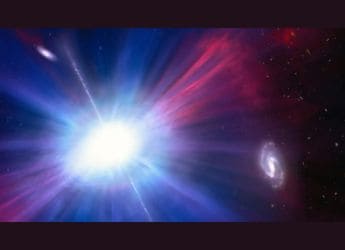- Home
- Science
- Science News
- Earliest Known Black Hole Found Just 500 Million Years After the Big Bang
Earliest Known Black Hole Found Just 500 Million Years After the Big Bang
JWST reveals the universe’s earliest confirmed black hole in a galaxy 13.3 billion years old.

Photo Credit: Erik Zumalt / The University of Texas at Austin
JWST captures a galaxy hiding the earliest confirmed black hole ever discovered
Astronomers have discovered the most distant black hole yet, an ancient quasar more than 13 billion light years from our own Earth, incredibly close to the limit of where scientists even expect supermassive black holes to form. The cosmic behemoth of a galaxy, known as CAPERS-LRD-z9, provides a wide-window echo back in time to one of the furthest peeks into our early universe yet, only shortly after the Big Bang, when our cosmos was a fraction (3%) of its current age. Now, researchers led by those in The University of Texas at Austin's Cosmic Frontier team have found what are likely very powerful gas outflows and also evidence that some of the very first black holes were born much, much heavier than previously believed.
Early Black Hole Found in ‘Little Red Dot' Galaxy Challenges Growth Models
According to a study published in The Astrophysical Journal this week, researchers led by those at The University of Texas at Austin's Cosmic Frontier team are announcing they have made the most sensitive measurements to date less than a billion years after the Big Bang, and these neonatal black holes were producing gas outflows fast enough — and over a long enough period — to halt stars forming in surrounding galaxies.
More recently discovered, the Little Red Dots galaxy appears to be just the sort of ominous-sounding crimson that would shoot a vibrant deep red due to intense radiation taking place among giant black holes and gas clouds.
A little galaxy of mass in all that more than enough of less, those hundreds of millions of suns among which all those stars are caught. This, in turn, birthed the supermassive galactic monsters — either quickly overcooked giants or premature sizes.
JWST high-z key science theme & imaging science exposure for mapping the process of supermassive black hole formation, growth, and evolution at high spatial detail.
Get your daily dose of tech news, reviews, and insights, in under 80 characters on Gadgets 360 Turbo. Connect with fellow tech lovers on our Forum. Follow us on X, Facebook, WhatsApp, Threads and Google News for instant updates. Catch all the action on our YouTube channel.
Related Stories
- Samsung Galaxy Unpacked 2025
- ChatGPT
- Redmi Note 14 Pro+
- iPhone 16
- Apple Vision Pro
- Oneplus 12
- OnePlus Nord CE 3 Lite 5G
- iPhone 13
- Xiaomi 14 Pro
- Oppo Find N3
- Tecno Spark Go (2023)
- Realme V30
- Best Phones Under 25000
- Samsung Galaxy S24 Series
- Cryptocurrency
- iQoo 12
- Samsung Galaxy S24 Ultra
- Giottus
- Samsung Galaxy Z Flip 5
- Apple 'Scary Fast'
- Housefull 5
- GoPro Hero 12 Black Review
- Invincible Season 2
- JioGlass
- HD Ready TV
- Laptop Under 50000
- Smartwatch Under 10000
- Latest Mobile Phones
- Compare Phones
- Honor Win RT
- Honor Win
- Xiaomi 17 Ultra Leica Edition
- Xiaomi 17 Ultra
- Huawei Nova 15
- Huawei Nova 15 Pro
- Huawei Nova 15 Ultra
- OnePlus 15R
- Asus ProArt P16
- MacBook Pro 14-inch (M5, 2025)
- OPPO Pad Air 5
- Huawei MatePad 11.5 (2026)
- Xiaomi Watch 5
- Huawei Watch 10th Anniversary Edition
- Acerpure Nitro Z Series 100-inch QLED TV
- Samsung 43 Inch LED Ultra HD (4K) Smart TV (UA43UE81AFULXL)
- Asus ROG Ally
- Nintendo Switch Lite
- Haier 1.6 Ton 5 Star Inverter Split AC (HSU19G-MZAID5BN-INV)
- Haier 1.6 Ton 5 Star Inverter Split AC (HSU19G-MZAIM5BN-INV)

















